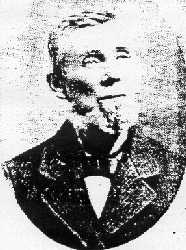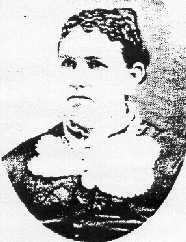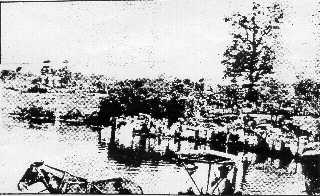Wednesday, July 6, 1988 The
Herald-News, Hardinsburg, Kentucky Page 11
Early Big Spring ....
The 'Dodge City' Of Its Time And Place
Back to Big Spring page; back to Stith Valley home page (This article was furnished by
Phil Johnson.)
By Betty Jefferies Morris
| This small village, resting at the point where Breckinridge, Meade and Hardin Counties
join, was once known as the "Dodge City" of its time and place, due to the three
saloons and violence in the town. In the early days, because of its location, Big Spring
did not receive attention from law enforcement officials as did other towns.
According to legend, it was a bit of a "wide-open" town; another legend tells
how people enroute to Big Spring were cautious about traveling through the "long
hollow" east of town, especially at night because of robbers.
The quiet, peaceful and serene little town of today in no way reflects the period of
time when Big Spring was a thriving center of trade, commerce, tourism and recreation. |

McHENRY MEADOR was a
very prominent citizen of Big
Spring. He owned and operated
the general and furniture store, the horse race track, the hotel and
saloon, and served as the town undertaker. |

MARY MEADOR was the wife
of McHenry Meador. They lived
in the elegant Big Spring home
that was later sold to Benjamin
Sommers Clarkson. Photo
courtesy of ... (missing text).... and Robert Griffith |
| The little group of buildings comprising Big Spring sit there, sun-baked and wearing
the look of age. They not only look old, but they are old, some dating back to the
pre-Civil War era. Surely, if the buildings in the small village could talk, they would
tell stories about struggle, strife, drama, courage, tr4agedy, affection, happiness, and
examples of "man's inhumanity to man."
Stories could be told about the early pioneers, Thomas Lincoln's visit, and the days when
Big Spring was the "shopping center" for a wide area of the state.
Stories could be told about the Civil War, of prisoners being held in the cellar and
being shot as reprisals. |
 |
Stories of guerrillas and the terror they brought could also be told. According
to local legend, Sue Mundy, one of the most vicious of the guerilla leaders, was captured
near what is now Irvington.
Mundy was brought to Big Spring and held in the cellar of the old general store, the
one that burned in recent years. He was then taken to Louisville, where he was
executed by hanging.
More stories could be told, some of which would be about runaway slaves being held in
the cellar while waiting for their masters to come for them.
Wile the dates of first arrivals in the Big Spring section are not known, they are
thought to have been during the late 1770s.
In 1780, Captain William, (Big Bill) Hardin, with his party, came down the Ohio River
to the point where Stephensport is now located. They turned up Sinking Creek to the
falls, where they landed. From here, they journeyed over land to find a suitable
site on which to build a fort.
Sometime later, the men discovered they were being followed by Indians. In order
to avoid a fight, they abandoned their plans and set out for Hynes Fort in Severns Valley
(Elizabethtown).
The men traveled all night until they reached a big spring where they paused to quench
their thirst and rest for awhile. It was in this spot (presumed to be Big Spring)
that the Indians overtook them and a fight ensued. A Mr. Sinclair was killed, the
others escaped to Hynes Fort.
Many towns in Kentucky claim the Lincoln family stopped there on their way to settle in
Indiana.
Big Spring, too, makes this claim and with probably more reason than most, as it
appears to be a direct route to where the Lincolns crossed the Ohio River.
It is claimed that Thomas Lincoln and his family made camp in a field near the spring
on land owned by a family by the name of Board.
One hundred years later, there were old timers in and around Big Spring who could point
out the trail the Lincolns took.
Some of the best farmland in the county can be found in the Big Spring area. In
the early 1800s, many people began buying tracts of land for farms and businesses.
Ernest Bewley, a 76 year-old resident of the town said, "My father told me many
times that when land was first sold in this area it went for 12.5 cents an acre.
This was in line with the wages, which were often no more than 5 cents a day."
For a time, Big Spring was a stage stop for the coaches running between Elizabethtown
and Hardinsburg (Hardin's Fort). The town gradually grew up in the early 1800s,
around the clear, cool spring that risen in Hardin County.
The spring flows about 50 feet, passing the junction of the three counties, then sinks
and reappears several times. It finally flows underground for three more miles to
emerge in the Sinking Creek, a tributary of the Ohio River.
In early days, a large tree bearing leaves that were three shades of green was called
the "Corner Tree" as it stood at the geographical point where the three counties
joined.
Big Spring residents claim that the leaves facing each county reflected a different
shade of green. A granite marker now sits near where the "Corner Tree" once
stood.
Big Spring served as a summer resort for people from Louisville and other places who
were seeking a restful place to get away from the heat and noise of a large city.
At one time there were two hotels, which usually filled in the summer months.
Some type of entertainment was always available for the many visitors. If the quiet
became too pronounced, there were plenty of events and activities with which to keep busy.
The most popular form of entertainment was found at the race track, owned by McHenry
Meador, a prominent resident of the town. Many fine horses were owned by some of the
citizens of Big Spring. Harness racing fans from all over Kentucky met there.
At this time, there was a saloon where the men could quench their thirst and idle away
time. Several red hot poker games were often held, and at times, someone would draw
a knife or gun on a member of the game who was caught cheating.
The county line between Breckinridge and Meade Counties was moved during the early days
and happened to pass through the center of the tavern.
With Breckinridge County being dry, and Meade County wet, the proprietor simply started
serving alcoholic beverages across the room on the Meade County side.
Herb Hodges, life-long resident of Big Spring said, "A fellow could buy a shot of
whiskey in one county and go across the room to Breckinridge County and drink it.
This often led to confusion when the sheriff tried to arrest someone.
If the sheriff was from one county, and the criminal was across the county line, the
law officer had no authority to arrest him. Often no arrests were ever made."
Dances were often held in homes or the dance hall, and a ten-pin alley attracted the
younger men.
At different times of the year, there were quilting parties, corn huskings and apple
peelings. Play parties were very popular with the summer visitors as well as the
locals.
For the more sober minded, there were two churches: a Methodist and a Baptist, at which
they could worship on Sunday and attend weekly prayer meetings.
Possibly the most exciting event that disturbed the serenity of this small village was
the tornado that struck the town in March 1849, killing several citizens and destroying
several buildings.
The Methodist Church was left in ruins, it was rebuilt in 1881; the Baptist Church was
built in 1884.
Near Big Spring one can easily locate Hurricane Hollow, named for the 1849 tornado that
swept its length before hitting the community. Another catastrophe hit the community
in about 1911, when it was almost destroyed by fire. The town has also survived
several droughts and floods.
In the 1870s, businesses flourished, a town plat had previously .....................
lots were sold to those wishing to settle in Big Spring.
Vine Grove, 10 miles northeast of the busy little town, was the major shipping point.
At this time the population in Big Spring was around 200.
It was during this time that two physicians, Drs. J.R. Gray and C.B. Arnold, practiced
in the town. The druggist was J.C. Smith.
Other businesses included: W.A. Burkhart, blacksmith, J. Caldwell, barber; Eskridge and
Brothers, blacksmiths; A. Grief, jeweler, tinnier and trunkmaker; T.B. Howard, hotel
proprietor; McHenry Meador, general and furniture store owner and undertaker .....
(missing text) ..... (mayor); T.A. Robinson, carpenter; James O. Sturn,
furniture; and G.A. Meador flour mill operator.
At one time, Big Spring supported a large distillery, owned by Jim Wheatley. It
was located behind and to the right of the Clarkson - Hardaway mansion.
The whiskey made at the distillery was known as "Big Spring Straight." Since
it was not sold in bottles, customers had to fill their own containers from spigots that
were on the end of each barrel.
(Continued Next Week)
 |
THE OLD BIG SPRING METHODIST CHURCH was the scene of this picture made in
days gone by. The church once had a membership of 230. At that time Big
Spring was a larger community than Elizabethtown. If you can identify anyone in this
picture please let us know. Left: This picture was made of the old Methodist Church
following Sunday morning worship. |

click photo to enlarge |

THIS COMMUNITY BAPTISM took place at Jimmy Burnett's pond at Sand Ridge. Many Big
Spring residents were baptized during this Sunday afternoon service in the early horse and
buggy days. Photo courtesy of Herb Hodges
| A CORNER STONE was placed near the spot where Breckinridge, Meade and
Hardin Counties join at Big Spring. The stone was erected in 1950 and the promoters
of the project to place the stone were the Rev. C.K. Dickey and George
Prather. Betty J. Morris photo |
 |






